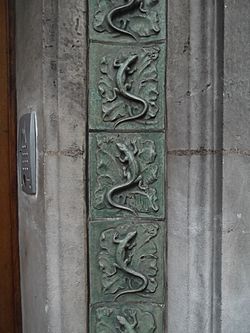Carrier's constraint facts for kids
Carrier's constraint is an interesting idea about how some animals move and breathe. It mostly affects air-breathing animals with backbones, like many reptiles and amphibians. These animals often bend their bodies from side to side when they walk or run.
The problem is, when they bend sideways, it makes it hard to breathe properly. One lung gets squashed while the other expands. This means they often just push old air from one lung to the other, instead of breathing out completely and taking in fresh air.
This idea was named after David R. Carrier. He wrote about this problem in 1987. An English scientist named Richard Cowen later gave it the name "Carrier's constraint."
Contents
What is Carrier's Constraint?
Carrier's constraint explains why some animals struggle to run and breathe at the same time. Imagine a lizard running very fast. As it moves, its body wiggles from side to side. This wiggling motion affects its lungs.
When the lizard bends its body to the left, its left lung gets squeezed. At the same time, its right lung stretches open. This makes it hard to get fresh air into both lungs. Instead, air might just move between the two lungs, which isn't very helpful for breathing.
Why is it a problem?
For animals that need a lot of oxygen, like when they are running fast, this is a big problem. They can't get enough fresh air into their bodies. This means they can't keep running for a long time.
Animals Affected by Carrier's Constraint
Many animals are affected by Carrier's constraint. These include most amphibians like frogs and salamanders, and many reptiles like lizards and crocodiles.
- Short Bursts of Speed: These animals can move very quickly, but only for short distances. They often hold their breath while running.
- Oxygen Debt: When they run without breathing, they build up an "oxygen debt." This means their body needs more oxygen than it's getting.
- Resting to Breathe: After a short burst of speed, they have to stop and rest to catch their breath. This helps them pay back their oxygen debt.
Think of a human sprinter running a 100-meter race. They often don't breathe during the race. Afterward, they might feel very tired and need to recover. Many reptiles and amphibians are like this. They are often "ambush predators," meaning they wait for their prey and then attack quickly. This lifestyle fits well with short bursts of speed.
You won't find reptiles or amphibians that can run long distances like dogs or deer. Their body design makes it hard for them to do that.
How Some Animals Overcome It
Even with Carrier's constraint, some animals have found clever ways to get around it.
- Snakes: Snakes are a good example. They only have one working lung. This means they don't have the problem of air shunting between two lungs.
- Dinosaurs: Many dinosaurs walked on two legs, just like humans. This is called bipedalism. When an animal walks on two legs, its body doesn't flex sideways as much. This allows them to breathe more easily while moving. Most dinosaur groups stayed bipedal throughout their history.
- Lizards: Lizards often run in short bursts and then pause. Scientists like David Carrier have shown that lizards do most of their breathing during these short pauses. This allows them to get enough oxygen before their next burst of speed.
Images for kids
-
A Leopard gecko resting. Lizards often breathe during pauses in their movement.
See also
 In Spanish: Limitación de Carrier para niños
In Spanish: Limitación de Carrier para niños



